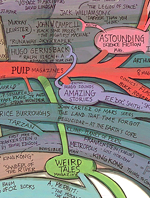
While science fiction didn’t start out in the pulps, they certainly played a key part of its development and growth in popularity.
But that connection can be hard to visualize. Not any more.
Brooklyn artist and educator Ward Shelley has made it easier for everyone to see the pulps’ role in the development of science fiction. His “History of Science Fiction” — a massive, H.P. Lovecraft-looking illustration — depicts the genre’s development in detail. (Ward describes it as “the figure of a tentacled beast, derived from H.G. Wells’ War of the Worlds Martians.” HPL comes first to my mind, maybe because I’ve been reading a bit of his stories lately.)
Shelley’s work is a winning entry in the 2011 Places & Spaces “Science Maps as Visual Interfaces to Digital Libraries” competition.
Shelley’s history runs from the twisting tentacles of “fear and wonder” in the beginning to “new space opera” between the lifeless eyes of the illustration’s head. The central artery — running from “gothic novels” through the head — contains the pulps and their predecessor penny dreadfuls and dime novels, with veins branching off leading to specific magazines (Amazing Stories, Weird Tales, Astounding Science Fiction) and pulp fictioneers (Edgar Rice Burroughs, Hugo Gernsback, John W. Campbell, E.E. “Doc” Smith).
Judges comments about the informational graphic include: “This inventive hand-drawn concept map draws the viewer into an engaging and instructive visual dialogue with the subject matter.” And “the map reminds me of the importance that human interpretation can have in casting information into an appealing visual framework.”
Take a look at it yourself. It’s fascinating.


Welcome back.
Thank you. I’ve got a list of blog topics stored up from the past few months. Now, to find time to write them up. 🙂